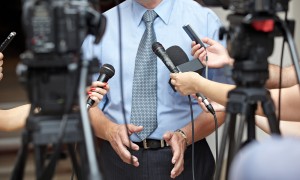This an excerpt of an interview with Anne Savage, a freelance/contract photographer based in Dexter, Mich. With her husband, Chris Savage, she helps produce a political blog. The site has four paid writers and is funded by readers and advertising.
Defend the role of the photojournalist. Why does your work still matter if a reporter can get content or a citizen journalist can provide the content?

Anne Savage
Visual journalists are as important as ever, if not more so, in the information age, despite the decision of media organizations to reduce the quality of visual content. Imagery is more present than ever. I believe the decision to replace experienced photojournalists with inexperienced visual communicators is a mistake that will cost the organization in the long run.
However, with the evolution of social media and the fast paced environment for sharing information, I understand the importance of being ‘out there’ quickly. The smartphone solves that problem, and there are plenty of instances where a reporter snapping a photo or short video to accompany their story makes sense. But, as a replacement for all reporting situation, it is a big mistake. News organizations need to decide what mediums would be best for the situation and who the appropriate people are to gather the content. The way we share information today is much more diverse than it used to be with just a printed product; therefore, the way we gather it should also be more diverse.
Related story: ‘Identity Crisis’ in Photojournalism
Photography is a constantly evolving medium and we, as visual journalists, need to change and adapt with it. It wasn’t even 10 years ago when I was listening the relentless grumbling from my film photography friends about digital photography. Now it’s the argument that everyone has a camera that is bringing people in my industry down. It bothered me, too, but I’ve moved on. What I see is a need for more and more visual content. Just in the last month Twitter changed its platform to automatically reveal images rather than having to click on a link to see them.
Facebook gets more likes and shares and views on images than anything else. Newspapers have complicated websites and reporters have their own blogs and Twitter accounts and Facebook pages. There are layers upon layers of virtual space to be filled with content and visual content is still the best way to grab potential readers.
Although it is true that many photographers are struggling to find work, I believe that if they are good and willing to adapt to the changing world of information sharing, they can be a relevant part of the process. If photographs are grabbing people’s attention, it seems to me that the trend of iPhone images taken by someone with zero training in visual communication will not last and professional image-makers will once again be needed. I think it is already happening.
What do you use to capture images?
I photograph everything with my professional Canon photography gear. I change lenses, I use external flashes, I often shoot in manual mode. I love my gear, I know it well, I can be depended on to shoot a great photograph under almost any situation. Plus, I am willing to try new things and use my creativity in different ways. This is how I have managed to run a successful photography business. I can be relied upon to get the image over and over and an image that rises above the noise. I work harder than I have ever worked and I push myself constantly, but that is how a photographer stays relevant today.
I don’t believe this is much different than writers. They have to write differently today. There are less thoughtful, highly researched pieces than there used to be. The need to be adaptable, fast, and learn the art of writing a good headline and opening paragraph is greater than it used to be. And, to top it all off they need to understand how to convey their story visually.
How much do your use your smartphone for professional photography?
I do not use it as an image-maker in my professional career. However, it is an important tool. In addition to photographing assignments with a card that records the images as raw files, I use an additional WiFi card in my Canon camera that records and transmits small, web-friendly images to my iPhone or iPad that can then be sent out instantly. This allows me to compete with the instant smartphone images, only mine will be taken with professional equipment and the quality will trump any smartphone image.
A great example of this was when Michigan Republicans were about to pass Right to Work legislation and union members from all over the state descended on the capitol in protest. They filled the lawn at the Capitol building as well as inside the rotunda of the Capitol. It was dark and capturing an image with a smartphone was difficult, but I was able to document the protest inside the building with my professional camera. (See image below.)

Union protestors inside the Michigan Capitol building. This photo was shot with professional gear by Anne Savage.
My tweets from inside the Capitol building went viral. People throughout the state wanted to see what was going on in the Capitol building and they did, through me.
How has the business changed since you were a student photographer?
That feels like a million years ago and a totally different person. I was just learning and had little confidence in my abilities as a photographer. I struggled a lot, and I learned a lot, even more than I was learning in my classes. The year I was photo editor a donor gave [the student newspaper] a Nikon scanner, a Macintosh computer and the very first version of Photoshop, with no manuals. I was asked to learn as much as I could and train others. I had a love-hate relationship with that equipment but I believe it was maybe the single most important learning experience for me in terms of becoming a digital artist. I was able to embrace the new technology with a lot more confidence than others in my industry.
As for the confidence as a photographer, well that came many, many years later but I got there and when I did my photography career began to excel. I take chances and I try anything. I do things like photograph a 360 degree interactive panoramic in a hot air balloon while it is being filled. When I photograph people I concentrate on them and their comfort rather than what I’m doing. I bring this last bit up because I believe a trained visual communicator needs to do so much more than take an image. We see our environment in ways others cannot, it’s natural to many artists but it needs to be fine-tuned in order for them to be great at what they do.
Will a writer be able to reach that kind of visual confidence so that their concentration can be on the writing and struggling to come up with an adequate photograph? Maybe, but my guess is not very often. When you require one person to report something in two different ways I believe you not only compromise the image but the writing as well. Plus, telling a story with two perspectives from two different people will always tell a better story.
Jackie Spinner (jackiespinner@mac.com) was a staff writer for the Washington Post for 14 years and covered the wars in Iraq and Afghanistan for the paper. She is the author of “Tell Them I Didn’t Cry: A Young Journalist’s Story of Joy, Loss, and Survival in Iraq.” Spinner is now an assistant professor of journalism at Columbia College Chicago and teaches smartphone photography and digital storytelling. She wrote about the closing of the foreign news bureaus in Baghdad in AJR’s April/May 2013 issue.








Leave a Comment